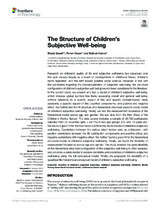| dc.contributor.author | Savahl, Shazly | |
| dc.contributor.author | Casas, Ferran | |
| dc.contributor.author | Adams, Sabirah | |
| dc.date.accessioned | 2021-06-14T15:37:34Z | |
| dc.date.available | 2021-06-14T15:37:34Z | |
| dc.date.issued | 2021-06 | |
| dc.identifier.citation | Savahl S. et al. (2021) The Structure of Children’s Subjective Well-being. Front. Psychol. 12:650691. doi: 10.3389/fpsyg.2021.650691 | en_US |
| dc.identifier.uri | http://doi: 10.3389/fpsyg.2021.650691 | |
| dc.identifier.uri | http://hdl.handle.net/10566/6276 | |
| dc.description.abstract | Research on children’s quality of life and subjective well-being has advanced over
the past decade largely as a result of developments in childhood theory, children’s
rights legislation, and the shift toward positive social science. However, in line with
the uncertainty regarding the conceptualization of subjective well-being, the structural
configuration of children’s subjective well-being has not been considered in the literature.
In the current study, we present and test a model of children’s subjective well-being,
which includes global (context-free items assessing overall and general well-being,
without reference to a specific aspect of life) and specific (domain-based items
assessing a specific aspect of life) cognitive components, and positive and negative
affect. We further test the fit structure of a hierarchical structural (second-order) model
of children’s subjective well-being. Finally, we test the measurement invariance of the
hierarchical model across age and gender. We use data from the third Wave of the
Children’s Worlds Survey. The data source includes a sample of 92,782 participants
selected from 35 countries (girls = 49.7%) in two age groups (10- and 12-years-old).
We found a good fit for the four-factor confirmatory factor model of children’s subjective
well-being. Correlations between the various latent factors were as anticipated—with
positive correlations between the life satisfaction components and positive affect, and
negative correlations with negative affect. We further found a good fit for the hierarchical
structural model of children’s subjective well-being. Finally, we found the tenability of
measurement invariance across age and gender. The study extends the generalizability
of the hierarchical structural configuration of the subjective well-being to child samples,
and provides a viable model to explore correlates and predictors of children’s subjective
well-being using the full conceptual model. Finally, we propound the tenability of a
quadripartite hierarchical conceptual model of children’s subjective well-being. | en_US |
| dc.language.iso | en | en_US |
| dc.publisher | Researchgate | en_US |
| dc.subject | Children’s subjective well-being | en_US |
| dc.subject | Confirmatory factor analysis | en_US |
| dc.subject | Hierarchical structural model | en_US |
| dc.subject | Children’s worlds survey | en_US |
| dc.subject | Structure of children’s subjective well-being | en_US |
| dc.title | The structure of children's subjective well being | en_US |
| dc.type | Article | en_US |

